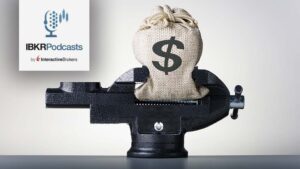Andrew Wilkinson, IBKR’s director of education, discusses the state of the economy and markets ahead of the November FOMC meeting with Jose Torres, the firm’s senior economist, and Steve Sosnick, chief strategist.
Summary – IBKR Podcasts Ep. 44
The following is a summary of a live audio recording and may contain errors in spelling or grammar. Although IBKR has edited for clarity no material changes have been made.
Andrew Wilkinson
Welcome to another episode of IBKR Podcasts. Our podcast this week has a focus on economics. Joining me today is Interactive Brokers chief strategist Steve Sosnick. Welcome Steve.
Steve Sosnick
Hello Andrew.
Andrew Wilkinson
And senior economist Jose Torres. Welcome, Jose.
Jose Torres
Good afternoon, Andrew.
Andrew Wilkinson
This edition is conveniently sandwiched between the September PCE report – and what that tells us about inflation pressures – and the October jobs report. And as if that wasn’t enough, we’ve also got the outcome of the FOMC’s November meeting on Wednesday. Steve, very briefly, since we’re now in November, did the stock market put in a meaningful low in October?
Steve Sosnick
A meaningful low yes. THE low — still too early to say. I’m still concerned about the idea that people are moving ahead, yet again. Though the pivot is off the table, they’re moving ahead to a pause or two. I’m sure we’ll talk about that more in the next few minutes. The other thing to keep in mind is QT is really just beginning. It’s very difficult to deflate this kind of balloon that they’ve inflated in an orderly manner. We already saw the gilt market come very close to breaking in the UK, and I don’t know what it will be, I can almost assure you something else will break as QT continues. As a result, I think it’s premature to just sort of say, “you know we had the low on September 30th, see you later.” I still believe that until or unless we see a meaningful change either in QT or Fed rate policy then we have not seen the absolute low.
Andrew Wilkinson
OK, very good. Let’s get back to the inflation that’s been hitting consumers really hard, whether it’s household goods, grocery stores, gasoline, dining out, or travel based on the most recent PCE data. Are we seeing any relief within those various categories in the index?
Jose Torres
On balance, barely any relief. Broad price pressures, with services leading the pack; the only price declines were in gasoline, and apparel. Gasoline relief, by the way, may be short lived. Gasoline is up in October relative to September, presenting a set-up of potentially discouraging inflation readings in November as gasoline shifts from a market tailwind over the last few months to an inflation headwind in the next few. Europe’s winter may complicate things further as supplies remain tight and production weak. An additional headwind can come from the possibility of a Chinese reopening, negative for oil price relief, but positive on the supply chain front. Apparel price softness is driven by excess inventory at retailers amidst declining demand, leading to discounts. Demand is slowing, and that’s positive for inflation. But is it quickly moving down to 2%? No, because supply factors continue to hamper progress on the inflationary front. Namely labor shortages, material shortages and supply chain and commodity complex inefficiencies.
Andrew Wilkinson
So which categories within the report are showing the largest price increases at this point, Jose?
Jose Torres
Mainly services. Within services, transportation, shelter, healthcare and financial services led the price increases. For the most part, these are essential services whose costs continue to increase against a backdrop of inelastic demand and higher wages once price increases are registered in these categories. They are difficult and perhaps nearly impossible to reverse. When an army of workers receives large wage increases and landlords increase rents to offset rising costs to save margins, those increases are sticky, price resistant and are characterized mostly by inelastic demand. Our economy isn’t conditioned to tell workers to expect reduced paychecks in the future or for landlords to expect lower rent rolls in the future. That’s why inflation in these categories is such a challenge. For inflationary expectations, there’s a risk of these increases being expected over the long haul, creating a feedback loop of higher inflation for longer.
Andrew Wilkinson
During the pandemic, individuals splurged on home renovations, creating their own home office or a home entertainment center. As the economy normalizes, have we seen a downswing in similar expenditures on those same goods and has it helped decrease cost pressures for consumer goods, do you think?
Jose Torres
We have seen a downsizing in goods spending. Unfortunately, the decrease in demand hasn’t offset production difficulties from a pricing perspective, so cost pressures have continued rising as demand continues to decline and production continues, improving the expectation of goods discounts. Relative to pre pandemic levels though, shipping costs remain high, supply chains remain pressured. The commodity complex remains inefficient, leading to materials shortages and higher costs. And labor shortages have also pressured goods production.
Andrew Wilkinson
Thinking about the November FOMC next, do you think that the Federal Reserve is frustrated with the PCE? Or has the Fed accepted that it will take quite a long time to get inflation under control? What’s your take on that?
Jose Torres
It’s been a challenge. It’s very tough to continue to see hot inflation readings after so many rate hikes. I think they’ve accepted that inflation is a tough opponent, and that market volatility and economic weakness are the expensive costs of victory. They’re expecting higher unemployment in 2023. That hasn’t manifested yet, which means they’re likely to stay aggressive here until they see more economic weakness. Chair Powell has been shortening his comments recently and communicating in an increasingly unambiguous manner. He understands that tilting towards an accommodative posture early can lead to another inflationary surge, like it did in the 1970s. Dovishness from central banks around the world, including Canada and Australia, are leading the market to believe that we’ve reached peak central bank hawkishness and that the appetite for more tightening is weakening. Any small hint of dovishness, or a touch of less aggressiveness, and the market may need may take that to mean 50 basis points instead of 75 in December, a slower pace of rate hikes and light at the end of the tunnel for investors. Bulls will take it and run with it.
Andrew Wilkinson
Steve, how might Friday’s payroll report influence the Fed thinking? Do they get a look at this for the actual meeting?
Steve Sosnick
Great question. I’ve always wondered about this. I know they get an advanced look. Well, I shouldn’t say, “I know this.” I’ve heard that they do. I’m not positive whether they do or don’t. Jose, do you have any sense of that? I actually think that payrolls are more or less off the table for the Fed. We’re at full employment, or perhaps beyond it. If you think of the Fed’s dual mandate as full employment and stable prices, then well, we’re pretty much good on the 1st part. The second part is the real problem, and they’ve told us that they’re willing to sacrifice employment in order to fight inflation. So, I don’t think the market’s going to make something of it. Well, they always do, but ultimately, I don’t think it changes the picture that much, barring a true outlier number. If it’s somewhere around consensus, markets will move, but I really don’t think it changes the Fed’s thinking all that much.
Andrew Wilkinson
Will we hear anything different from Chairman Powell at the FOMC press conference afterwards? What do you think?
Steve Sosnick
I think he’s going to be much more careful about making comments that could be interpreted as pivoting or pausing, et cetera. Think about what happened in July when he used the term that could have been interpreted as we’re at a neutral policy. That was widely interpreted as that we’re at a neutral policy, ignoring, of course, the fact that he said pretty much two sentences later that we’re going to a restrictive policy. But the markets took that as the Fed is going to pivot. He then had to come out at Jackson Hole and spank the market and say no. And that was when stocks began to decline. That only ended at the end of the quarter. So, from mid-August through late September, it was a nasty market. I think he wants to avoid that. There are also hints that the Fed is going to be a little more judicious with guidance. And so, I think that the tone is maybe we should be expecting what I’m going to call a more mysterious Chairman Powell. We’re taping this on Halloween, so I don’t want to say that he’s going to be a market ghoul or spook the market, but I do think that we’ll have a little bit of an air of mystery as we go forward.
Andrew Wilkinson
Jose, your final thoughts on the Fed? Are they in keeping with Steve’s views or are you thinking differently at this point?
Jose Torres
I’m thinking pretty similarly. It’s going to be a trick-or-treat Wednesday for the Fed. I think it’s time to put the genie back in the bottle for good. Chair Powell understands that if they don’t tackle inflation now, the longer it persists, the higher the challenge. Later taking the path of least resistance of just accepting higher inflation is really bad for the economy in the medium to long term. I do think that being unambiguous and being clear on inflation being the main problem, given that, like Steve said, employment is already so strong. I think that’s the play here.
Andrew Wilkinson
Gentlemen, thank you very much for joining us today. We have Steve Sosnick, the chief strategist here at Interactive Brokers and Jose Torres, our senior economist. Thank you both.
Steve Sosnick
Thank you.
Jose Torres
Thank you, Andrew, my pleasure.
Andrew Wilkinson
Don’t forget to check us out on ibkr.com and look out for IBKR Campus under the education menu. Thanks for joining me again today, bye everybody.
Disclosure: Interactive Brokers
The analysis in this material is provided for information only and is not and should not be construed as an offer to sell or the solicitation of an offer to buy any security. To the extent that this material discusses general market activity, industry or sector trends or other broad-based economic or political conditions, it should not be construed as research or investment advice. To the extent that it includes references to specific securities, commodities, currencies, or other instruments, those references do not constitute a recommendation by IBKR to buy, sell or hold such investments. This material does not and is not intended to take into account the particular financial conditions, investment objectives or requirements of individual customers. Before acting on this material, you should consider whether it is suitable for your particular circumstances and, as necessary, seek professional advice.
The views and opinions expressed herein are those of the author and do not necessarily reflect the views of Interactive Brokers, its affiliates, or its employees.



















